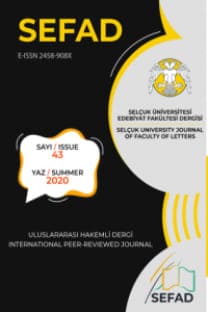MODERNİST Mİ, ROMANTİK Mİ? NİMA YUSHIİ’NİN HİKAYELERİNDE SANATSAL ÖĞELER
Nima Yushij’in Afsaneh’i devrim niteliğindeki serbest nazımı ile Modern İran Şiiri açısından bir mihenk taşı olarak kabul edilmektedir. Bununla birlikte, yeni bir çağ açmış olan bu mihenk taşının biçemsel sınıflandırması açısından alanyazında yaygın olarak yanlış bir kabul baskın görülmektedir. Sanatsal özellikleri açısından Modernistten daha çok Romantik akıma ait olarak ifade edilmesinin daha uygun olduğu aşikâr olan Afsaneh’in tam tersi bir şekilde anıldığı gözükmektedir. Böylelikle mevcut çalışma Nima Yushij’in Afsaneh’inin yanlış yorumlanan şu anki durumuna, akademik ilgiyi modernist ve modern kavramlarının anlamsal farkına çekmeye ek olarak, şiirin romantik akıma ait unsurlarının detaylı olarak incelenmesi yoluyla ışık tutmayı denemektedir.
Anahtar Kelimeler:
Afsaneh, romantizm, modernizm, modern.Afsaneh, modern
MODERNIST OR ROMANTICIST? ARTISTIC ELEMENTS IN NÎMA YUSHIJ’S AFSANEH
Nima Yushij’s Afsaneh, with its revolutionary free verse style, is acknowledged to be a touchstone for Modern Persian Poetry. Yet, a common misconception seems to be prevalent in the literature as to the stylistic classification of this touchstone which ushered in a new era. Afsaneh, for which it sticks out to be more proper to be pronounced as romanticist rather than modernist in terms of its artistic features appears to be designated the other way round. Accordingly, the present study seeks to shed light on the recent misinterpreted situation of Nima Yushij’s Afsaneh via scrutinizing its romanticist elements in addition to drawing the academic attention to the semantic difference between the concepts; modernist and modern.
Keywords:
Afsaneh, romanticism, modernism, modern,
___
- BARRY, Peter (1995). Beginning Theory: An Introduction to Literary and Cultural Theory. New York: Manchester University Press.
- ERFANI, Mohammad Javad & NOSRATİ, Fatemeh (2015). The Effect of Nima Yushij’s “Afsaneh (Myth)” Verse Collection on Modern Lyric Poetry. Journal of Engineering Research and Applications 5 (2): 41-46. Retrieved from http://www.ijera.com/papers/Vol5_issue2/Part%20-%204/I502044146.pdf [02.03.2017].
- FORWARD, Stephanie (n.d.). Discovering Literature: Romantics and Victorians. Retrieved from https://www.bl.uk/romantics-and-victorians/articles/the-romantics#authorBlock1 [03.02.2017]
- HILLMANN, Michael Craig (1982). The Modernist Trend in Persian Literature and Its Social Impact. Iranian Studies, 15 (1): 7-29. Retrieved from http://www.jstor.org/stable/4310378 [18.02.2017].
- KARIMI-HAKKAK, Ahmad, & TALATTOF, Kamran (2004). Essays on Nima Yushij: Animating Modernism in Persian Poetry. Leiden; Boston: Brill.
- MILANI, Abbas (2008). Eminent Persians: The Men and Women who Made Modern Iran, 1941-1979. New York: Syracuse University Press.
- NAFICY, Majid (1999). Modernism and Ideology in Persian Literature: A Return to Nature in the Poetry of Nima Yushij. K-H. Ahmad & K. Talattof (eds.).
- ORASKHAN, Mohammad Hussein & ZOHDI, Esmaeil (2016). Following the Trace of Byronic Hero in Yushij's Afsaneh. International Journal of English Language & Translation Studies, 4 (2): 126-137. Retrieved From http://www.eltsjournal.org [20.04.2017].
- ORASKHAN, Mohammad Hussein & ZOHDI, Esmaeil (2016). Nima Yushij's "Afsaneh" as a Striking Exemplar of the 'Greater Romantic Lyric'. International Letters of Social and Humanistic Sciences (66) : 23-30. doi: 10.18052/www.scipress.com/ILSHS.66.23
- PAPAN-MATIN, Firoozeh (2004). Love: Nima’s dialogue with Hafez. In K-H. Ahmad & K. Talattof (eds.) Essays on Nima Yushij: animating modernism in Persian poetry. 173-192. Leiden; Boston: Brill.
- TALATTOF, Kamran (2000). The Politics of Writing in Iran: A History of Modern Persian Literature. New York: Syracuse University Press.
- WHITE, Craig (n.d.). the Romantic Period, Movement, Style, & Spirit. Retrieved from http://coursesite.uhcl.edu/HSH/Whitec/terms/R/Romanticism.htm [15.03.2017].
- Yayın Aralığı: Yılda 2 Sayı
- Başlangıç: 1981
- Yayıncı: Selçuk Üniversitesi Edebiyat Fakültesi
Sayıdaki Diğer Makaleler
NATSUME SŌSEKİ’NİN ESERLERİNDE MODERNLEŞME VE BATI İLE JAPONYA’NIN MUKAYESESİ
TOPLUMSAL DÜNYANIN BEDENSEL TEMELLERİ: DURKHEİM, SİMMEL VE WEBER SOSYOLOJİSİNDE BEDENİN YERİ
MRS WARREN’S PROFESSION’DAN PRESS CUTTINGS’E: GEORGE BERNARD SHAW’UN OYUNLARINDA KADIN SORUSU
FRANSA MİLLÎ KÜTÜPHANESİNDEKİ CÖNKLERDE ÂŞIK ÖMER ADINA KAYITLI ŞİİRLER
VOLTAİRE’İN ESERİ ZADİG’TE ADALET VE MUTLULUK ARAYIŞI
BİR ANTİ-ROMANTİK VE ANTİ-MODERNİSTİN SANATI: LARKİN’İN MODERN GERÇEKLİK ÜZERİNE DÜŞÜNCELERİ
MODERNİST Mİ, ROMANTİK Mİ? NİMA YUSHIİ’NİN HİKAYELERİNDE SANATSAL ÖĞELER
DİVAN ŞİİRİ-CÖNK İLİŞKİSİ VE “CÖNK” REDİFLİ GAZELLER
SIMON DER Kİ BAĞLAMSAL OLMALI: ÇEVİRİ ÇALIŞMALARI DERSLERİNDE KELİME ÖĞRETİMİ
